
Бесплатный фрагмент - Idioms and phrasal verbs in business communication
G.B. Atayeva
IDIOMS AND PHRASAL VERBS IN BUSINESS COMMUNICATION
(English language)
Ingliz tili» fanidan til va iqtisod yo‘nalishi bo‘yicha tahsil olayotgan oliy o‘quv yurtlari talabalari va professor-o‘qituvchilar uchun o‘quv qo‘llanma
Toshkent 2025
Idioms And Phrasal Verbs in Business Communication (English language) O‘quv qo‘llanma. G.B. Atayeva.
Ushbu o‘quv qo‘llanma talabalarga ish yuritish muloqotining o‘ziga xos xususiyatlarini tushunishga, ularning so‘z boyligini idiomalar va frazeologik fe’llar hisobiga kengaytirishga, shuningdek, ularni yozma va og‘zaki nutqda, ish yozishmalarida va tarjimada tanib olish va qo‘llashni o‘rganishga yordam berishga mo‘ljallangan.
Qo‘llanmada turli janrlarda: intervyu, ommaviy nutq, maqola, muharrirga xat va sar’atlarda idiomalar va frazeologik fe’llarning qo‘llanilishiga misollar keltirilgan. Bundan tashqari, ularning yig‘ilishlar, taqdimotlar, muzokaralar va telefon orqali suhbatlar kabi turli ish muloqoti sohalarida qo‘llanilishi ko‘rib chiqilgan.
Qo‘llanma turli kontekstlarda idiomalar va frazeologik fe’llarni amaliy o‘zlashtirishga qaratilgan ko‘plab mashqlarni o‘z ichiga oladi: ma’lumotni tuzilash, so‘zlovchining aytilganlarga munosabatini ifodalash, suhbatdoshlarning his-tuyg‘ularini yetkazish uchun.
Materialni o‘zlashtirishni tekshirish uchun testlar, shuningdek, ma’lumotnoma materiallari mavjud. Qo‘llanma filologiya va iqtisodiyot yo‘nalishlari talabalari, shuningdek, ish ingliz tilini o‘rganuvchilar uchun foydali bo‘ladi.
Данное учебное пособие призвано помочь студентам разобраться в особенностях делового общения, расширить их словарный запас за счет идиоматических выражений и фразовых глаголов, а также научиться распознавать и использовать их как в письменной, так и в устной речи, в деловой переписке и при переводе.
В пособии представлены примеры использования идиом и фразовых глаголов в различных жанрах: интервью, публичных выступлениях, статьях, письмах в редакцию и заголовках. Кроме того, рассматривается их применение в различных сферах деловой коммуникации, таких как совещания, презентации, переговоры и телефонные разговоры.
Пособие включает в себя множество упражнений, направленных на практическое освоение идиом и фразовых глаголов в разных контекстах: для структурирования информации, выражения отношения говорящего к сказанному, передачи эмоций и чувств собеседников.
Для проверки усвоения материала предусмотрены тесты, а также прилагается справочный материал. Пособие будет полезно студентам филологических и экономических специальностей, а также всем, кто изучает деловой английский язык.
This textbook is designed to help students understand the specifics of business communication, expand their vocabulary through idioms and phrasal verbs, and learn to recognize and use them in both written and oral speech, business correspondence, and translation.
The textbook provides examples of the use of idioms and phrasal verbs in various genres: interviews, public speeches, articles, letters to the editor, and headlines. In addition, their application in various areas of business communication, such as meetings, presentations, negotiations, and telephone conversations, is considered.
The textbook includes a multitude of exercises aimed at the practical mastery of idioms and phrasal verbs in different contexts: for structuring information, expressing the speaker’s attitude towards what is said, and conveying the emotions and feelings of the interlocutors.
Tests are provided to check the assimilation of the material, as well as reference materials. The textbook will be useful for students of philology and economics, as well as for anyone studying Business English.
Taqrizchilar: M.M.Kurbanova –PhD, dotsent (TDTrU)
M.B. Ganixanova — PhD, dotsent (TDTU)
© Toshkent Davlat Transport Universiteti, 2025
Muqaddima
Ishbilarmonlik muloqotida ifoda vositalarini standartlashtirishga intilishga qaramay, ingliz tilidagi ish yuritish nutqi iboralar va metaforalarga boy. Bu tendensiya bir tomondan ish yuritish muloqoti normalarining erkinligini ko‘rsatsa, ikkinchi tomondan, ishbilarmonlar hamjamiyatining intellektual his-tuyg‘ular va individuallikni ifodalashga bo‘lgan ichki intilishining aksidir.
Idiomalar har bir soha ishbilarmoni so‘z boyligining ajralmas qismidir. Biroq, ularni o‘zlashtirish ko‘pincha jiddiy qiyinchiliklar bilan bog‘liq, bu esa idiomalarni yaxlit semantik birlik sifatida qabul qilish va yodlash kerakligi bilan izohlanadi. Shu munosabat bilan talabani ish yuritish muloqotining turli sohalarida faol qo‘llash uchun idiomalarning to‘g‘ri ishlatilishiga oid yetarli miqdordagi misollar bilan ta’minlash zarurati tug‘iladi.
Ushbu o‘quv qo‘llanma uchta mustaqil qismdan iborat bo‘lib, ular ish yuritish muloqoti tilini o‘rganishning asosiy komponentlariga, jumladan, muloqot ko‘nikmalari (communication skills), til funksiyalari (language functions) va ish yuritish diskursining mazmunli jihatlariga (business content) mos keladi.
O«quv qo‘llanma ikkita vazifani hal qiladi. Birinchi vazifa — ish yuritish muloqotining og‘zaki turi (taqdimotlar, muzokaralar, telefon orqali muloqot, yig‘ilishlar, ommaviy nutqlar), shuningdek, o‘ziga xos hissiy holatni ifodalashni talab qiladigan ba’zi yozma ifoda shakllari (jurnal maqolalari, muharrirga xatlar) iboralardan foydalanishning yuqori chastotasiga ega ekanligini isbotlash. Ikkinchi vazifa — ish yuritish muloqoti muammolarini tushunish uchun asos yaratish, o‘quvchini ish yuritish hamkorligining yozma va og‘zaki shakllarida turli mazmundagi matnlar bilan tanishtirishdir.
Idiomalarni o‘zlashtirish uzoq vaqt va mashaqqatli jarayon bo‘lgani uchun, qo‘llanmada ularni faollashtirishning tsiklik usuli qo‘llaniladi. U ularni turli vaziyatlarda va kontekstlarda bir necha bor taqdim etishdan iborat.
MUNDARIJA
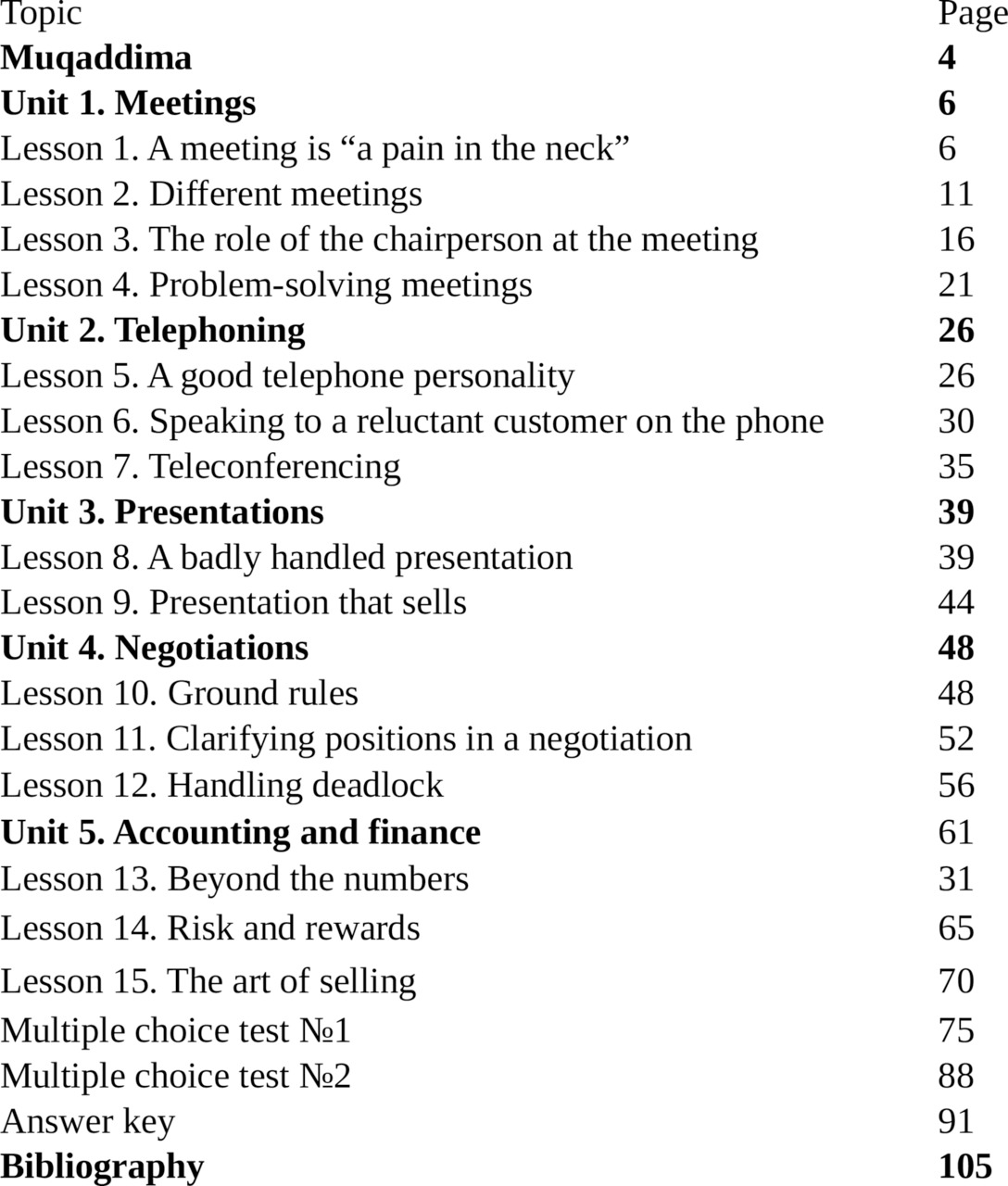
UNIT 1. MEETINGS
LESSON 1. A MEETING IS «A PAIN IN THE NECK»
Lesson Aims:
— To learn and master 19 idioms and phrasal verbs related to business and meetings.
— To practice using the target vocabulary in controlled and semi-controlled exercises.
— To develop comprehension and translation skills.
— To apply the new vocabulary in a practical speaking task.
Ex.1 Warm-Up. Instructions: Discuss the following questions with a partner.
— Think about the last meeting you attended (at work, university, etc.). What was its purpose? Was it effective? Why or why not?
— In your opinion, what are the top 3 ingredients for a successful meeting?
— What does the English idiom «a pain in the neck» mean? How can it relate to meetings?
Exercise 2. Study the following vocabulary items. Note down their definitions and translations to memorize them. Make 6 sentences using active vocabulary.
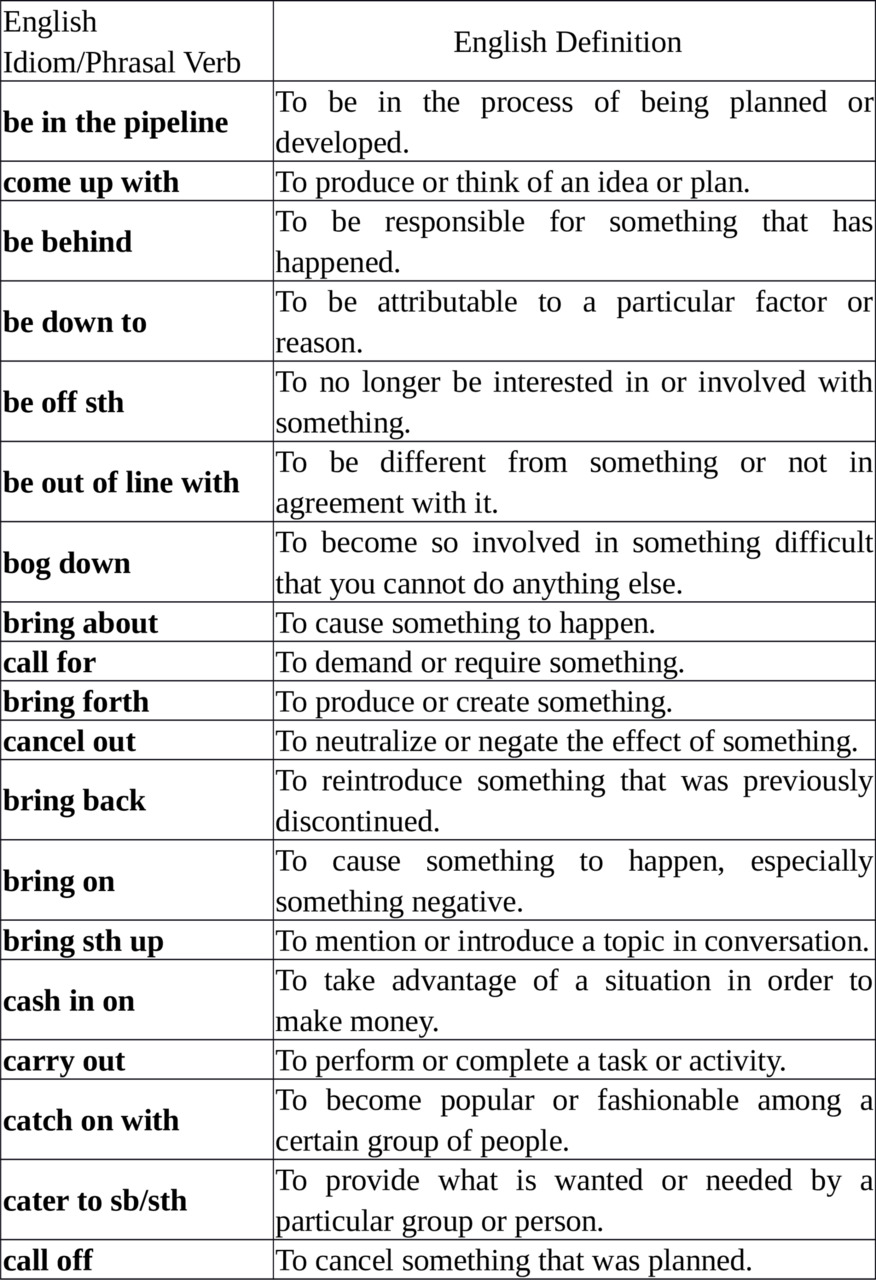
Ex.3 Vocabulary Translation
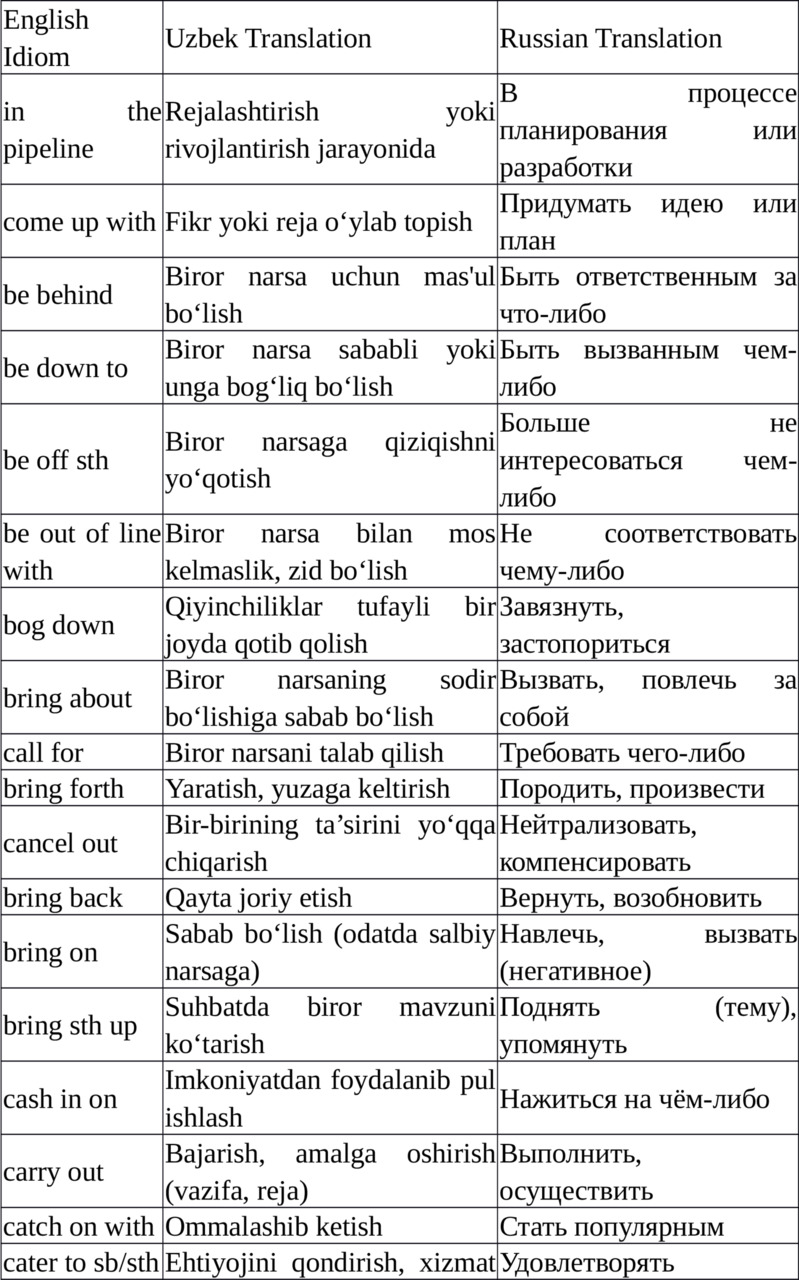

Exercise 4. Match the idioms and phrasal verbs on the left with their correct definitions on the right.
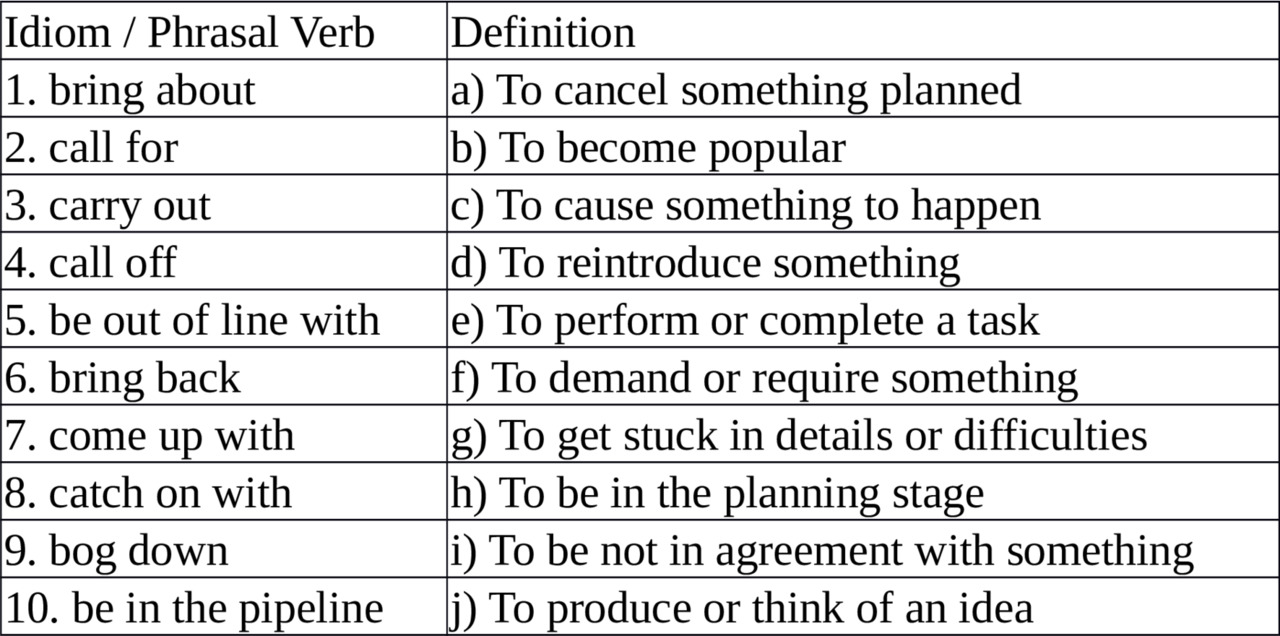
Exercise 5. Complete the sentences using the correct idiom or phrasal verb from the box.
be behind, is down to, bring on, bring up, cash in on, cater to, cancel out
— The company’s financial problem _______________ poor management.
— The marketing team is trying to _______________ the new trend for vintage-style products.
— I wanted to _______________ the salary issue at the meeting, but I was too nervous.
— Who do you think _______________ the idea to move our office to a new location?
— The long hours and heavy workload can _______________ a lot of stress.
— The high shipping costs unfortunately _______________ the discount we offer.
— Our new software is designed to _______________ the specific needs of architects.
Exercise 6. Rewrite each sentence using the idiom in parentheses so that it has the same meaning
Example: They had to cancel the flight due to bad weather. (call off)
→ They had to call off the flight due to bad weather.
— This difficult problem requires a creative solution. (call for)
— The project got stuck because there was too much paperwork. (bog down)
— The company decided to reintroduce its most popular product from the 1990s. (bring back)
— The new CEO’s policies created significant changes in the company culture. (bring about)
— We must perform a detailed market analysis before launching the product. (carry out)
Exercise 7. a) Translate the following sentences into your native language
The team needs to come up with a new strategy by Friday.
— The new regulations brought about many challenges for small businesses.
— We had to call off the outdoor event because of the rain.
b) Translate the following sentences into English using a suitable idiom or phrasal verb from the vocabulary list.
— (UZ) Bizning yangi mahsulotimiz yoshlar orasida tezda ommalashdi.
— (RU) Наш новый продукт быстро стал популярным среди молодёжи.
— (UZ) Uning taklifi kompaniya siyosatiga mutlaqo mos kelmadi.
— (RU) Его предложение совершенно не соответствовало политике компании.
— (UZ) Yangi loyiha hali rejalashtirish bosqichida.
— (RU) Новый проект всё ещё находится на стадии планирования.
Exercise 8. Reading and Understanding
Some people dread meetings more than Monday mornings. They find them boring, unproductive and far too long. When a regular meeting is in the pipeline, people either come up with excuses or ignore them altogether. Have you ever thought about what is behind people’s fears? In most cases, the failure is down to the absence of purpose. Some employees are off meetings because they are afraid that their contributions will be out of line with their boss’s expectations. Some meetings though bog down for lack of ideas. Besides, the reluctance of employees can be brought about by their unpreparedness. When a meeting is called for, memos should be circulated in advance. If a meeting doesn’t bring forth expected results, it may cancel out all your efforts. My advice on how to bring back employees’ commitment is simple: bring on no more than ten participants, bring up questions that demand urgent consideration, never call off a meeting, and don’t let people cash in on criticisms. If you don’t carry out these instructions, meetings will never catch on with employees. They must cater to everybody’s requirements.
Comprehension Questions:
— According to the text, why do some employees dislike or avoid meetings? Name at least two reasons.
— What does the author suggest to do when a meeting is «called for»?
— What negative effect can a meeting that «doesn’t bring forth results» have?
Exercise 9. Complete the dialogue using the phrasal verbs from the box. Use each phrase only once.
get bogged down, bring it up, came up with, carry out, call for
Manager: Okay team, this situation is serious. It will __________immediate action. We’ve lost two major clients this month.
Anna: I agree. I _____________ an idea last night. What if we offer a loyalty discount to our existing clients?
Mark: That’s a good start. But how do we implement it? We need a clear plan that we can _____________ immediately.
Manager: Exactly. Let’s focus on the solution. I don’t want to _____________ in blaming each other for the past.
Anna: I also have a concern about our current software. Should I __________ now or wait?
Manager: Let’s discuss that in our next meeting. For now, Let’s focus on the client loyalty plan.
Exercise10. Imagine you are at a meeting. You have two minutes to promote a new product or an idea to your team. Prepare a short speech (a «pitch»). You must use at least FOUR of the vocabulary items from this lesson.
Use this plan to develop your ideas:
— Introduction: State the problem or opportunity. (e.g., «Our current process often bogs down…»)
— The Solution: Present your idea. (e.g., «I’ve come up with a solution that will…»)
— The Benefits: Explain the positive results. (e.g., «This will bring about more efficiency and…»)
— Call to Action: Suggest the next step. (e.g., «This situation calls for a quick decision. I believe we should carry out a pilot test…»)
LESSON 2. MAKING MEETINGS MORE EFFECTIVE
Lesson Aims:
— To learn and master 13 idioms and phrasal verbs related to managing and improving meetings.
— To practice using the target vocabulary in controlled and semi-controlled exercises.
— To develop comprehension and translation skills.
— To apply the new vocabulary in a practical writing or speaking task.
Ex.1 Warm-Up. Instructions: Discuss the following questions with a partner.
— What actions can a manager take to clamp down on unproductive or overly long meetings?
— In your opinion, what is the best way to beef up team participation in a meeting?
— Have you ever been at odds over an idea with a colleague? How did you resolve the disagreement?
Exercise 2. Study the following vocabulary items. Note down their definitions and translations to memorize them. Make 6 sentences using active vocabulary.
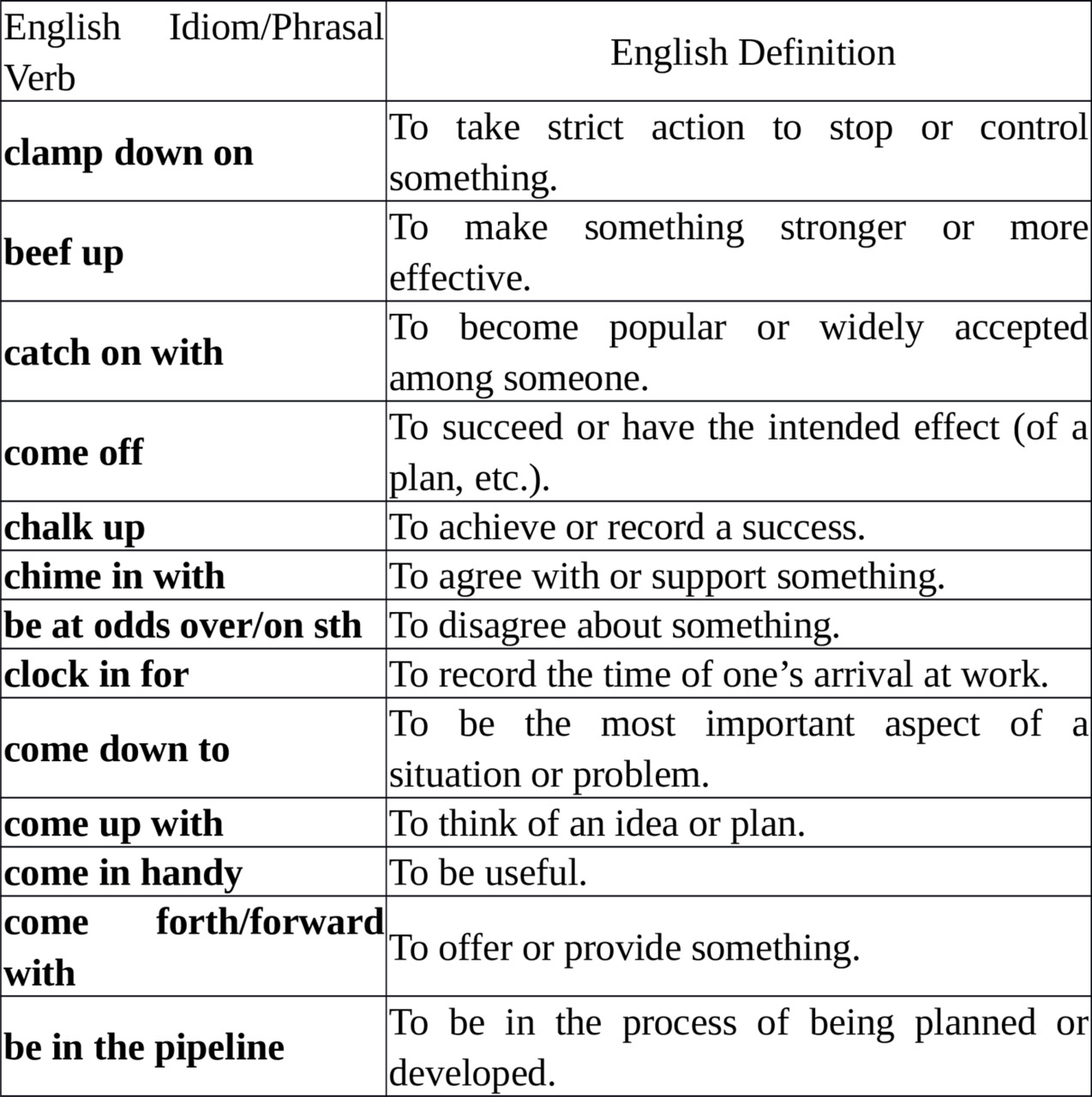
Ex.3 Vocabulary Translation
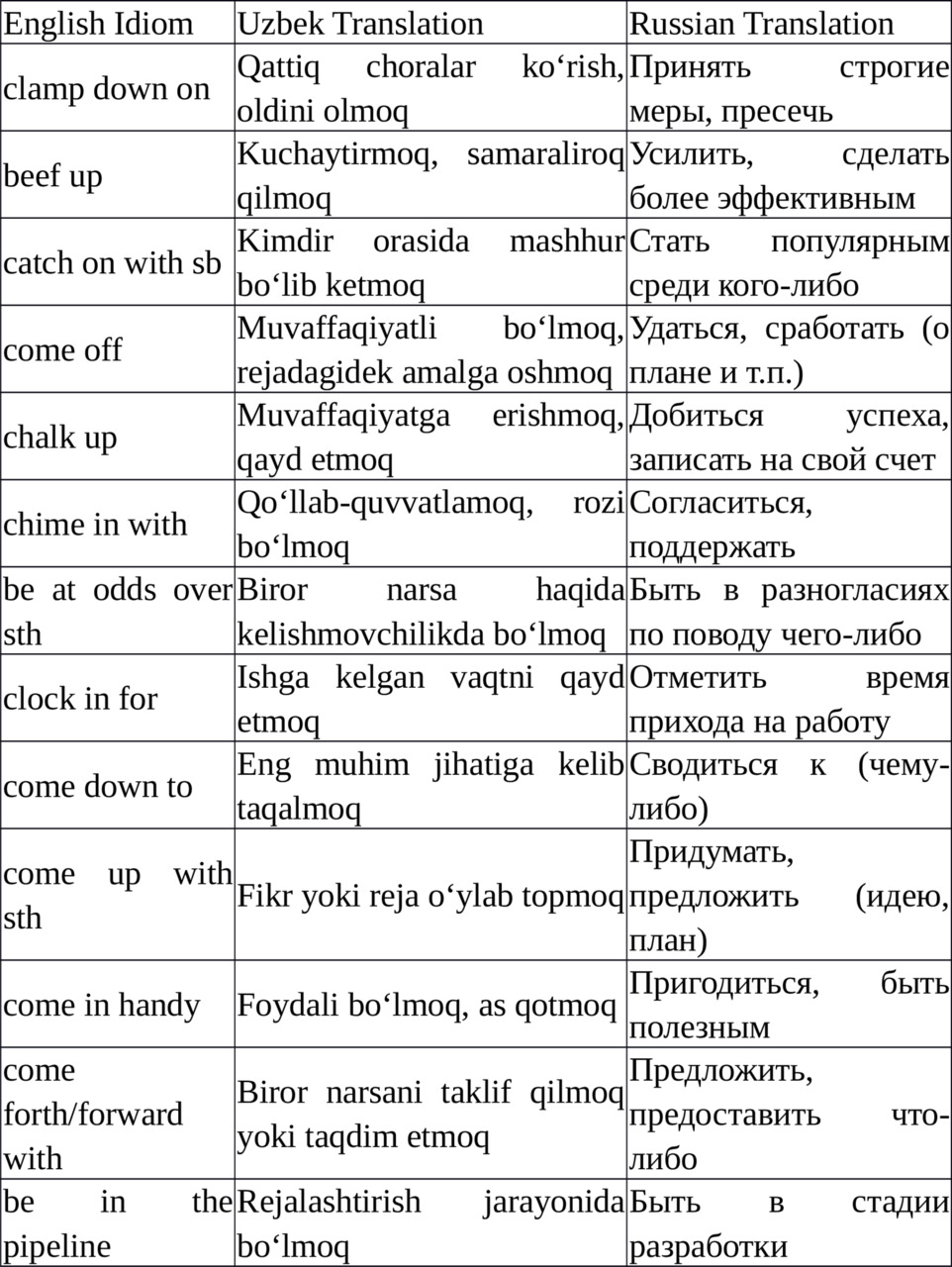
Exercise 4. Match the idioms and phrasal verbs on the left with their correct definitions on the right.
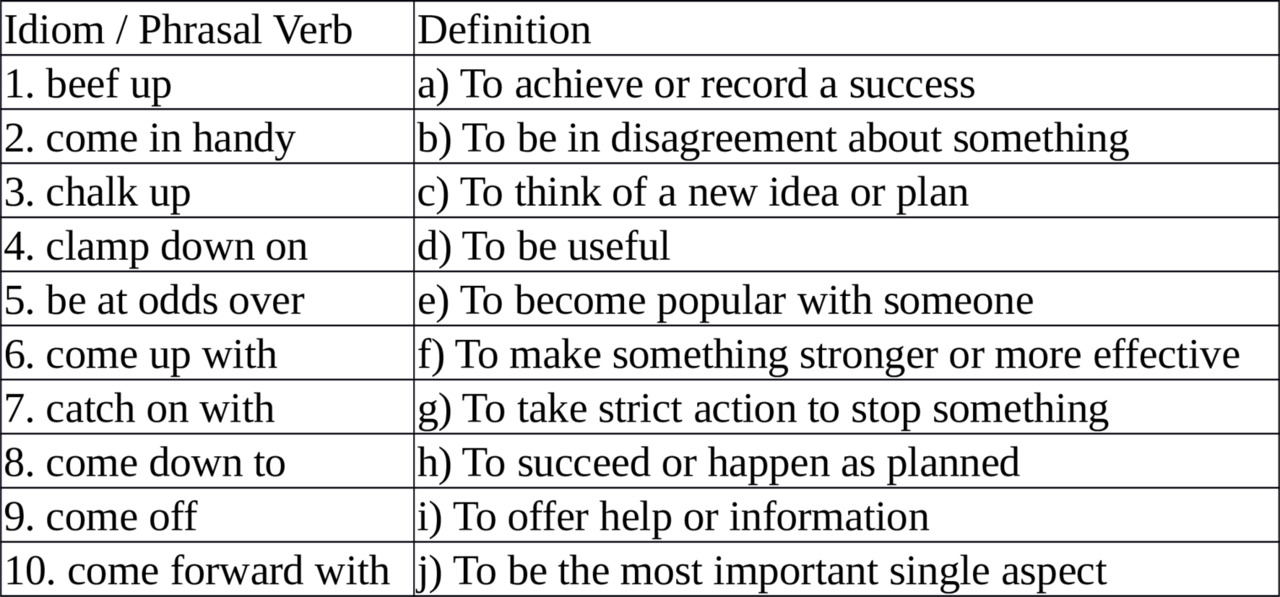
Exercise 5. Complete the sentences using the correct idiom or phrasal verb from the box.
be in the pipeline, beef up, came up with, comes down to, chalk up, chime in with, clamp down on
— We need to _______________ security after the recent data breach.
— The management has decided to _______________ lateness to meetings.
— Ultimately, business success _______________ one thing: customer satisfaction.
— The marketing team hopes to _______________ another record-breaking sales quarter.
— A few new projects _______________, but they haven’t been announced yet.
— Sara _______________ a brilliant idea to save the company money.
— His suggestions _______________ our team’s goals, so everyone agreed.
Exercise 6. Rewrite each sentence using the idiom in parentheses so that it has the same meaning.
Example: They had to cancel the flight due to bad weather. (call off)
→ They had to call off the flight due to bad weather.
— I hope our new marketing plan is successful. (come off)
— The company needs to get stricter about employees misusing company resources. (clamp down on)
— After hours of brainstorming, we finally thought of a solution. (come up with)
— No one offered any suggestions during the meeting. (come forward with)
— This extra battery will definitely be useful during our trip. (come in handy)
Exercise 7. a) Translate the following sentences into your native language.
— The board of directors is at odds over the new budget proposal.
— Let’s hope the new flexible working hours policy will catch on with the employees.
— The success of this project comes down to effective teamwork.
b) Translate the following sentences into English using a suitable idiom or phrasal verb from the vocabulary list.
— (UZ) Biz taqdimotimizni kuchaytirish uchun ko‘proq statistika qo’shishimiz kerak.
— (RU) Нам нужно добавить больше статистики, чтобы усилить нашу презентацию.
— (UZ) Kompaniya yana bir muvaffaqiyatli yilni qayd etdi.
— (RU) Компания записала на свой счёт ещё один успешный год.
— (UZ) Yaxshi lug‘at imtihon paytida juda as qotadi.
— (RU) Хороший словарь очень пригодится во время экзамена.
Exercise 8. Reading and Understanding.
Of course, managers can clamp down on employees’ reluctance to attend meetings, but it is not effective at all. A better way is to beef up the role of meetings and make them catch on with employees. After a lot of effort, the managers’ new approach to meetings came off. Now they can chalk up some success by classifying meetings by purpose.
Some meetings are held to share information, where participants say if they chime in with the opinions expressed, or if they are at odds over some points. When it comes down to problem-solving meetings, the aim is not just to come up with ideas but also to put solutions into practice. The venue is also important. Employees hate being forced to clock in for a formal meeting. As a result, it may come in handy to arrange informal «stand-up» meetings where everyone can come forward with solutions. These new types of meetings are productive, and more genuine ideas are still in the pipeline.
Comprehension Questions:
— According to the text, what is a better alternative to clamping down on employees?
— What is the main goal of a «problem-solving meeting»?
— Why might a «stand-up meeting» be more effective than a formal one?
Exercise 9. Complete the dialogue using the phrasal verbs from the box. Use each phrase only once.
chime in with, comes down to, beef up, come up with, at odds over
Manager: The feedback on our new app has been poor. We need to ___________ its features and performance.
Team Lead: I agree. I think it all ___________ the user interface. It’s not intuitive.
Developer 1: I have to disagree. The UI is fine. The real problem is server speed.
Manager: So, you two are ___________ the core problem. We need to investigate both. What we really need is a creative solution. Can anyone ___________ a new idea?
Developer 2: I ___________ the Team Lead. A simpler interface would solve 80% of the complaints.
Exercise 10. Imagine you are at a meeting. You have two minutes to propose an improvement for your company or department. Prepare a short speech (a «pitch»). You must use at least FOUR of the vocabulary items from this lesson.
Use this plan to develop your ideas:
— Introduction: State the problem or opportunity. (e.g., «We need to beef up our customer service response times…»)
— The Solution: Present your idea. (e.g., «I’ve come up with an idea for a new training program that I think will really catch on with the team…»)
— The Benefits: Explain the positive results. (e.g., «This new system will come in handy for tracking progress…»)
— Call to Action: Suggest the next step. (e.g., «I’d like to come forward with a detailed plan next week…»)
LESSON 3. THE ROLE OF THE CHAIRPERSON
Lesson Aims:
— To learn and master 15 idioms and phrasal verbs related to chairing and managing meetings.
— To practice using the target vocabulary in controlled and semi-controlled exercises.
— To develop comprehension and translation skills.
— To apply the new vocabulary in a practical speaking or writing task.
Ex.1 Warm-Up. Instructions: Discuss the following questions with a partner.
— Can you describe a time when a project or discussion started to get bogged down? What was the reason?
— What part of your job or studies currently cries out for more attention or improvement?
— Think of a big upcoming project. Why do you think the project manager has his/her work cut out for them?
Exercise 2. Study the following vocabulary items. Note down their definitions and translations to memorize them. Make 6 sentences using active vocabulary.
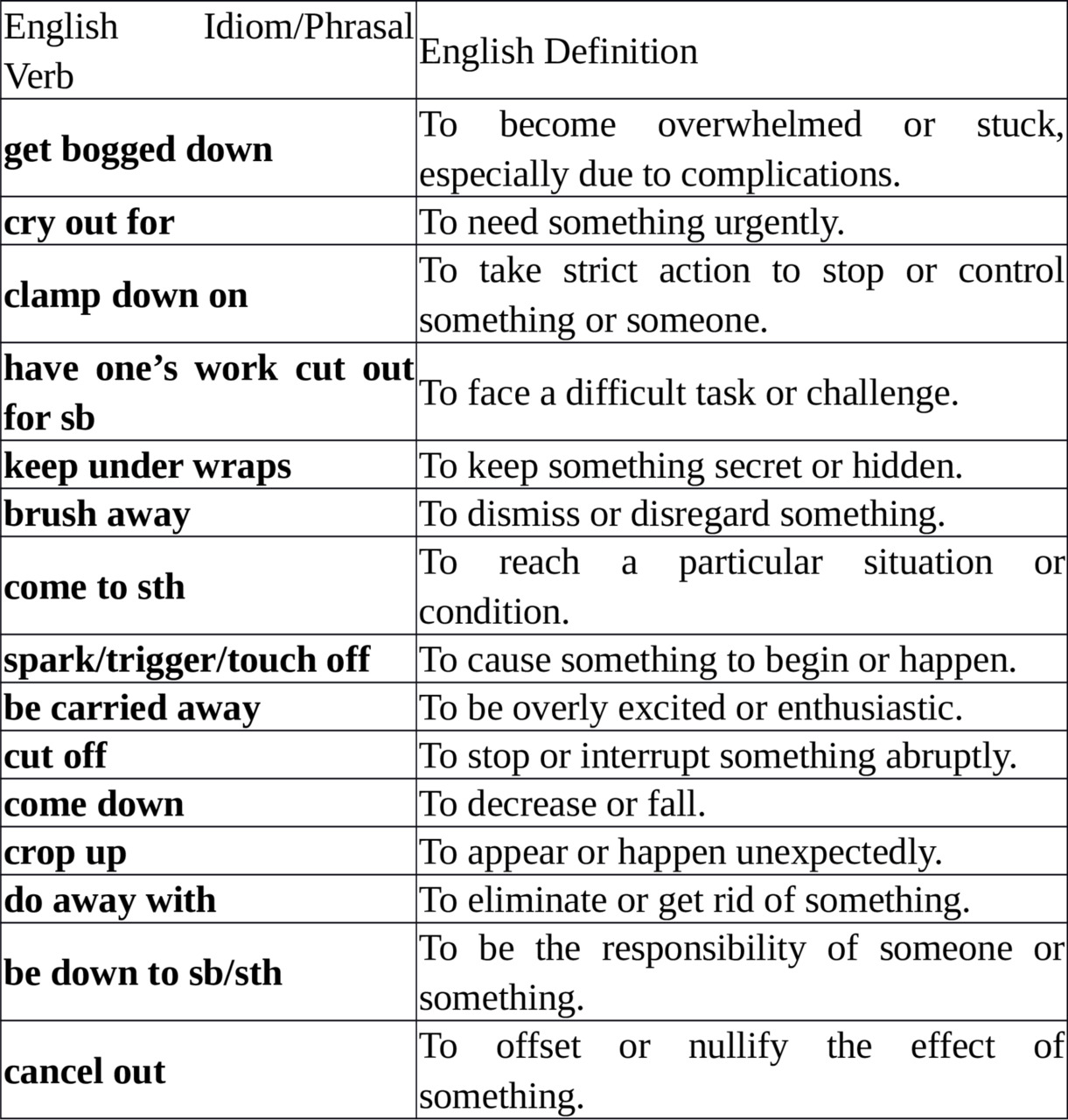
Ex.3 Vocabulary Translation
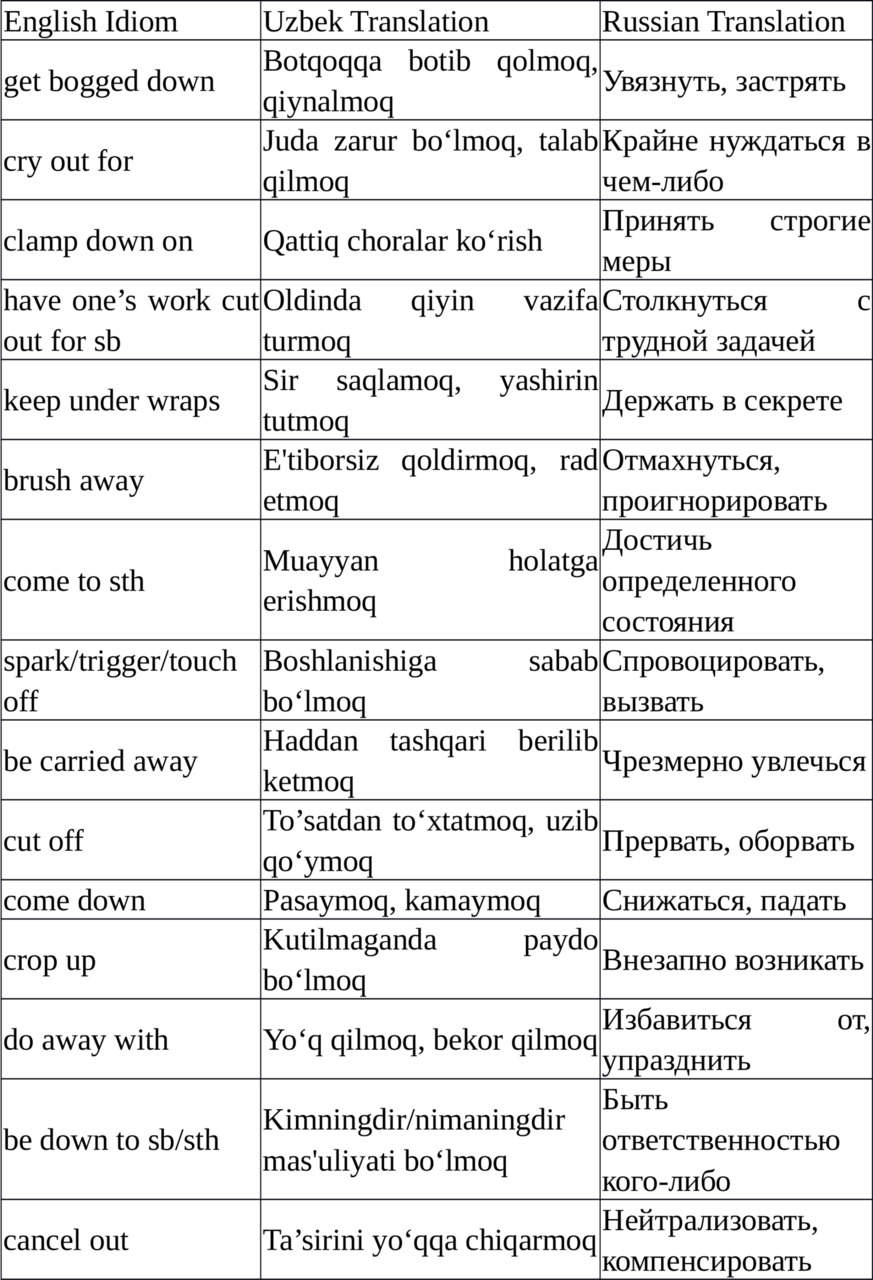
Exercise 4. Match the idioms and phrasal verbs on the left with their correct definitions on the right.
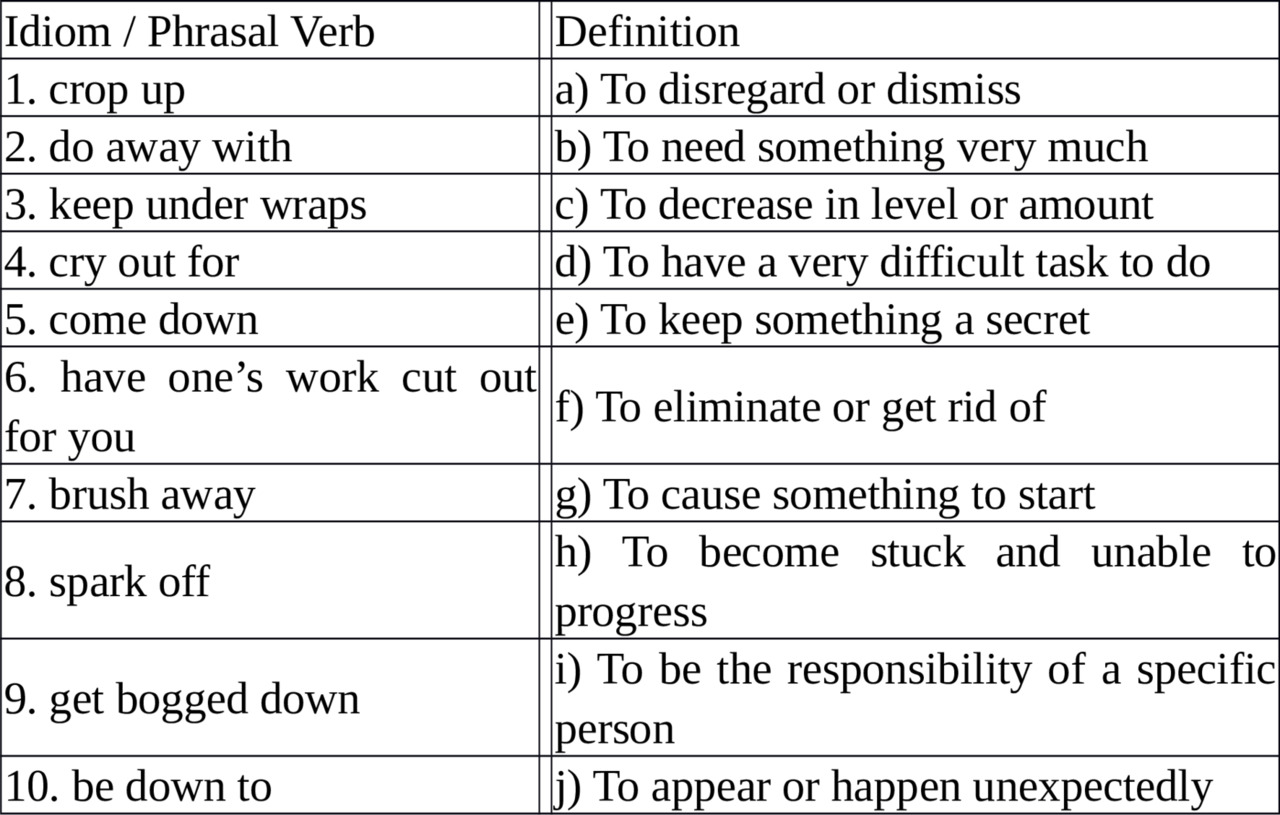
Exercise 5. Complete the sentences using the correct idiom or phrasal verb from the box.
be carried away, clamp down on, cut off, be down to, spark, do away with, cancel out
— The manager had to _______________ the speaker because he was going way over his allotted time.
— The new policy is intended to _______________ inefficient and outdated procedures.
— The announcement of bonuses is sure to _______________ a lot of excitement among the staff.
— His brilliant idea was exciting, but we shouldn’t _______________; we need to check the budget first.
— We need to _______________ unauthorized use of company vehicles.
— The success of this launch will _______________ the marketing team.
— The savings from the new software will unfortunately _______________ the increased cost of materials.
Exercise 6. Rewrite each sentence using the idiom in parentheses so that it has the same meaning.
Example: They had to cancel the flight due to bad weather. (call off)
→ They had to call off the flight due to bad weather.
— The project details are being kept secret for now. (keep under wraps)
— With three new projects starting at once, we face a very difficult task. (have our work cut out for us)
— Let’s not get stuck discussing minor details. (get bogged down)
— Several unexpected problems appeared last week. (crop up)
— He simply dismissed my concerns as unimportant. (brush away)
Exercise 7. a) Translate the following sentences into your native language.
— The company’s old IT system cries out for a complete upgrade.
— The fall in profits was down to increased competition in the market.
— The new CEO decided to do away with the formal dress code.
b) Translate the following sentences into English using a suitable idiom or phrasal verb from the vocabulary list.
— (UZ) Uning ehtiyotkorsiz sharhi jamoada qizg‘in bahs-munozaraga sabab bo‘ldi.
(RU) Его неосторожный комментарий спровоцировал бурную дискуссию в команде.
— (UZ) Narxlar pasayganda, biz ko‘proq mahsulot sotib olamiz.
— (RU) Когда цены снизятся, мы закупим больше продукции.
— (UZ) Ijobiy mijoz fikrlari yomon matbuot ta’sirini yo‘qqa chiqardi.
— (RU) Положительные отзывы клиентов нейтрализовали эффект плохой прессы.
Exercise 8. Reading and Understanding.
A lot of key people get bogged down in meaningless meetings. What should be done? All meetings cry out for a leader who will clamp down on discussions that go off-topic. This is the duty of the chairperson, who truly has his work cut out for him.
The chairperson must not keep the purpose of the meeting under wraps. It should be stated clearly. If the purpose is clear, the group itself will brush away irrelevant ideas. When it comes to discussions, the chairperson must let one suggestion spark another. They must ensure that loud members, who get carried away, do not dominate or cut off ideas from others. If some unrealistic idea crops up, the chairperson must politely do away with it to keep the discussion realistic. Remember that an unsuccessful meeting is often down to the incompetence of the chairperson. Bad leadership will cancel out any chance of a productive meeting.
Comprehension Questions:
— According to the text, what is a key duty of a chairperson regarding the discussion?
— What should a chairperson do when an unrealistic idea «crops up»?
— Who is usually responsible («is down to») when a meeting is unsuccessful?
Exercise 9. Complete the dialogue using the phrasal verbs from the box. Use each phrase only once.
got bogged down, cut off, cries out for, do away with, crop up
Manager: How is the project planning going, Sarah?
Sarah: It’s been slow. We _____________ in a debate about the budget for two days.
Manager: I see. This situation _____________ a clear decision. We need to move forward.
Sarah: I agree. And some new technical issues have started to _____________.
Manager: Okay, Let’s _____________ the old plan and start fresh with a new approach. I don’t want to be _____________ by bad news again, so Let’s focus on solutions.
Exercise 10. Imagine you are at a meeting. You have two minutes to give a speech on «The 3 Golden Rules for an Effective Chairperson.» Prepare a short speech (a «pitch»). You must use at least FOUR of the vocabulary items from this lesson.
Use this plan to develop your ideas:
— Introduction: State the importance of the chairperson’s role. (e.g., «A meeting often cries out for strong leadership to avoid getting bogged down…»)
— Rule 1: Present your first rule. (e.g., «First, a chairperson must not brush away new ideas, even if they seem strange…»)
— Rule 2 & 3: Present your other rules. (e.g., «Second, they must clamp down on anyone who tries to cut off another speaker…»)
— Conclusion: Summarize the benefits. (e.g., «Following these rules is down to the chairperson, and it ensures no one’s time is wasted.»)
LESSON 4. PROBLEM-SOLVING MEETINGS
Lesson Aims:
— To learn and master 11 idioms and phrasal verbs related to problem-solving and decision-making.
— To practice using the target vocabulary in controlled and semi-controlled exercises.
— To develop comprehension and translation skills.
— To apply the new vocabulary in a practical speaking or writing task.
Ex.1 Warm-Up. Instructions: Discuss the following questions with a partner.
— What’s the best way to deal with a problem that crops up unexpectedly in the middle of a project?
— Imagine your team is launching a major new product. How would you leave nothing to chance?
— Why is it important for a company to come to grips with changes in the market?
Exercise 2. Study the following vocabulary items. Note down their definitions and translations to memorize them. Make 6 sentences using active vocabulary.
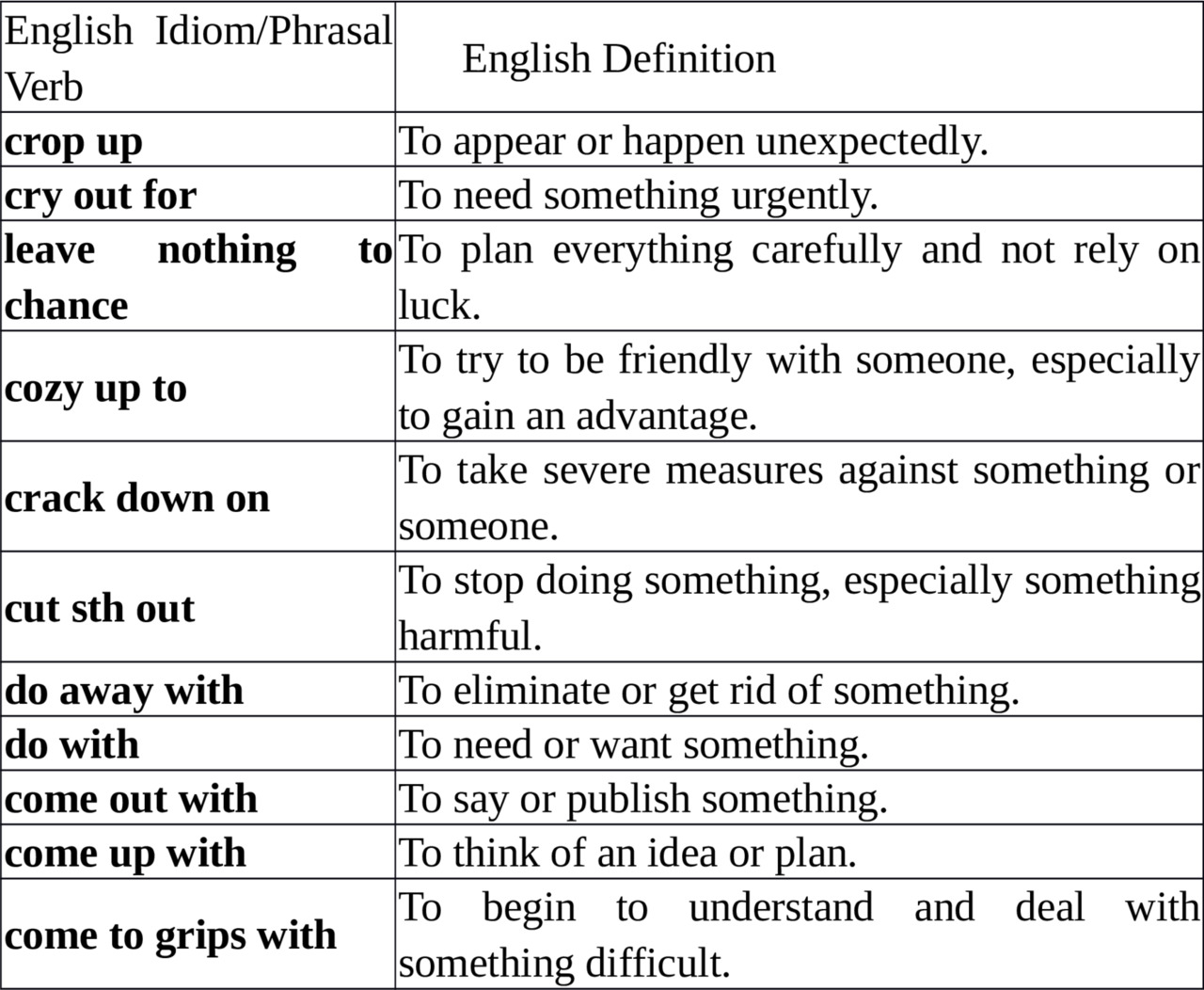
Ex.3 Vocabulary Translation
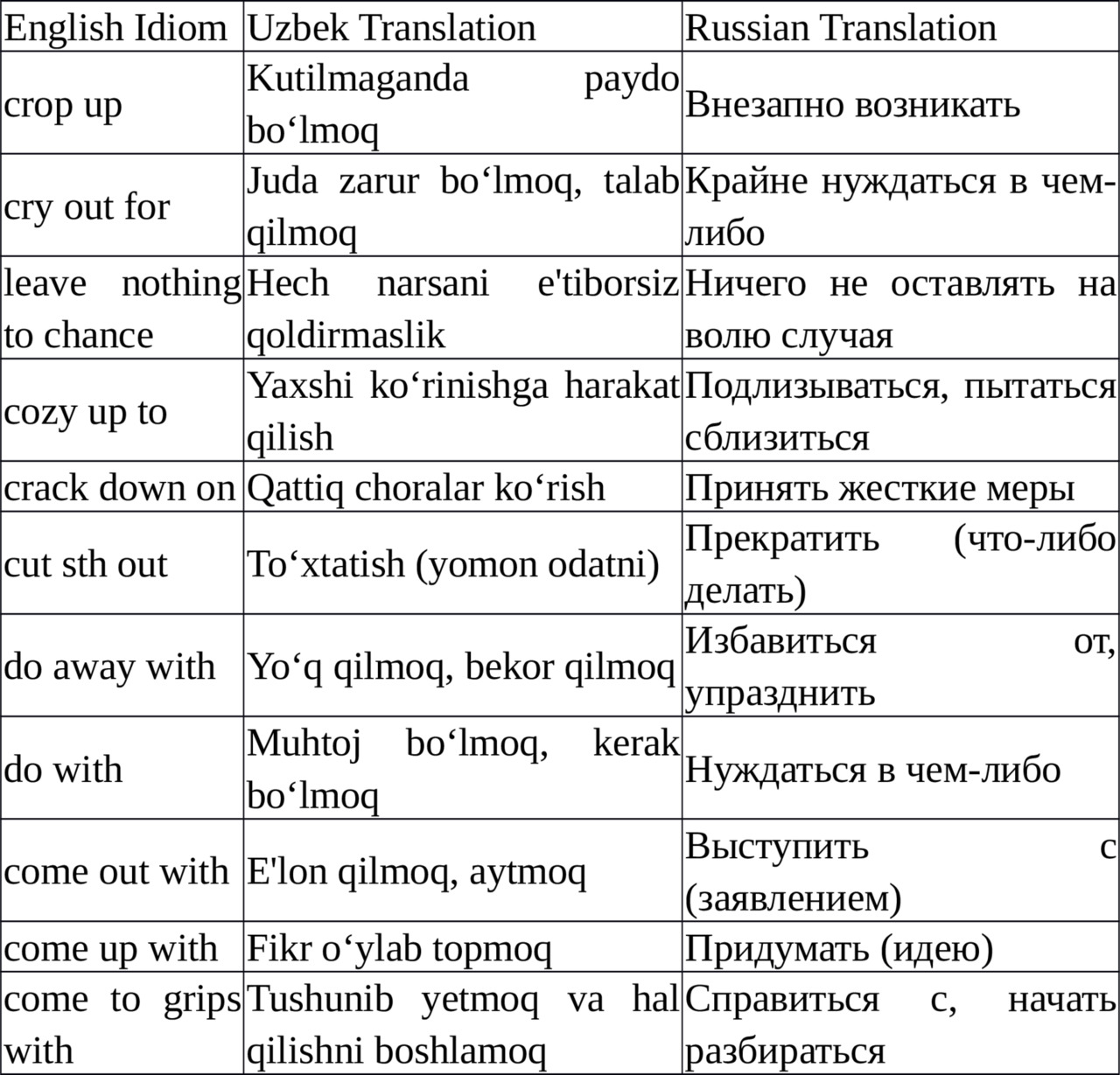
Exercise 4. Match the idioms and phrasal verbs on the left with their correct definitions on the right.
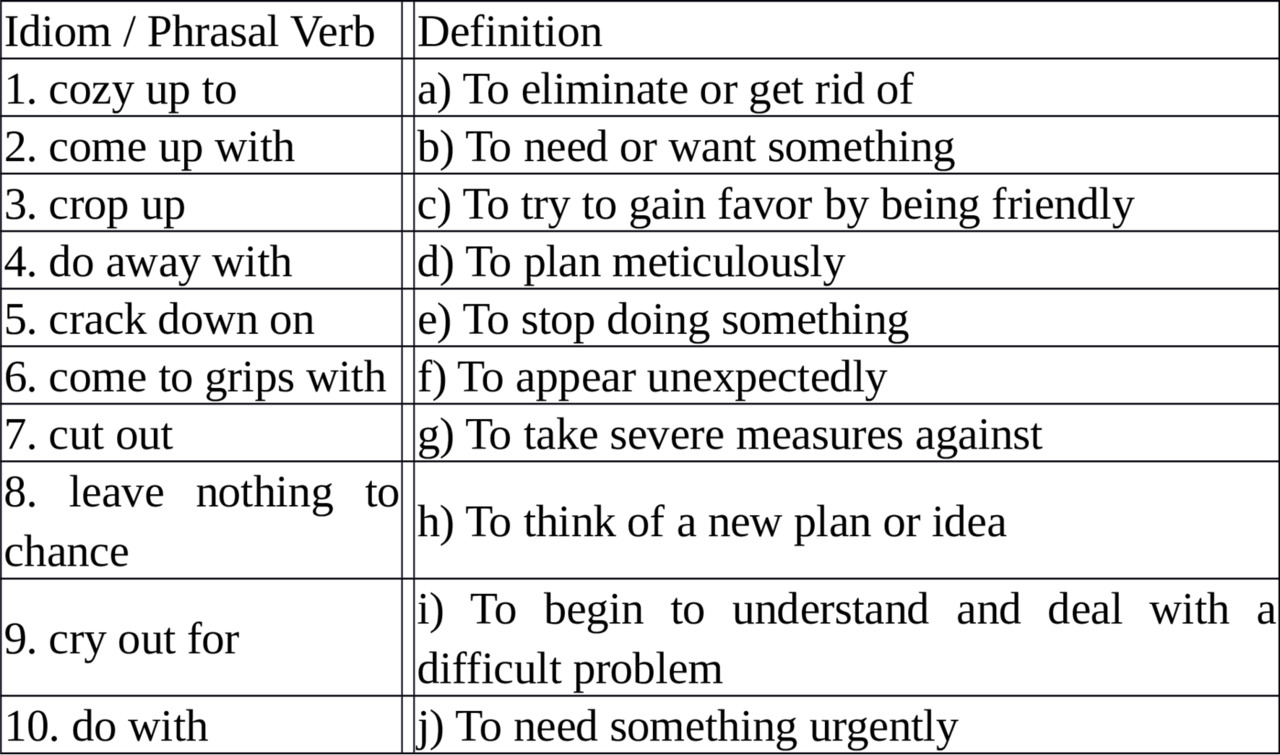
Exercise 5. Complete the sentences using the correct idiom or phrasal verb from the box.
come out with, come up with, cozy up to, cried out for, leave nothing to chance, do away with, come to grips with
— Our company needs to _____________ the reality of the new market competition.
— The old filing system was so inefficient that it _____________ replacement.
— The project manager is so meticulous; she tries to _____________.
— Tomorrow, the CEO will _____________ a statement about the company’s future.
— He was seen trying to _____________ the director, probably hoping for a promotion.
— We need to _____________ a better solution than this.
— The new policy will _____________ all the old, complicated forms.
Exercise 6. Rewrite each sentence using the idiom in parentheses so that it has the same meaning.
Example: They had to cancel the flight due to bad weather. (call off)
→ They had to call off the flight due to bad weather.
— We need more time to finish this report. (do with)
— The city council decided to take severe measures against illegal parking. (crack down on)
— You should stop eating so much junk food. (cut out)
— Several new opportunities appeared after we launched the website. (crop up)
— It took me a while to understand and handle the new software. (come to grips with)
Exercise 7. a) Translate the following sentences into your native language.
— The team was asked to come up with some new ideas for the ad campaign.
— For this launch to be a success, we must leave nothing to chance.
— The government plans to crack down on tax evasion.
b) Translate the following sentences into English using a suitable idiom or phrasal verb from the vocabulary list.
— (UZ) U o‘zining eski, samarasiz ish uslublarini yo‘q qilishi kerak.
— (RU) Ему нужно избавиться от своих старых, неэффективных методов работы.
— (UZ) Bizning boshqaruvimiz yangi g‘oyalarga juda muhtoj.
— (RU) Наше руководство отчаянно нуждается в свежих идеях.
— (UZ) Kompaniya kecha yangi mahsulot haqida e’lon qildi.
— (RU) Вчера компания выступила с анонсом нового продукта.
Exercise 8. Reading and understanding.
When a complex problem crops up, you must leave nothing to chance. An approach that this situation cries out for is to define the problem and analyze information. Unlike idea-generating meetings, the goal of a problem-solving meeting is clear. For example, if there is friction between departments, the goal is to improve how they relate. It’s up to the groups to come up with methods to overcome obstacles. Everyone expects action to follow the meeting — a commitment to do away with the problem.
Sometimes, there are external constraints like time or money. For example, if you know a competitor will soon come out with a new product, you could do with a problem-solving meeting. Don’t waste time. You must come to grips with the situation. You and your team should convene a meeting to crack down on your rival’s potential advantage by changing your strategy urgently.
Comprehension Questions:
Бесплатный фрагмент закончился.
Купите книгу, чтобы продолжить чтение.